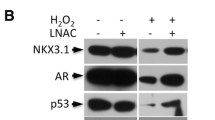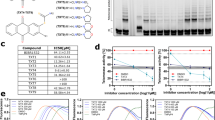Abstract
Background: The level of activity of the telomerase has been shown to correlate with the degree of invasiveness in several tumor types. In addition, cellular redox state is believed to regulate the secretion of matrix metalloproteinase-2 (MMP-2).
Aims: To determine the effect of anti-sense telomerase treatment of prostate cancer cells on MMP-2 activity, and the reactive oxygen and nitrogen species (two effectors of cellular redox state).
Methods: Anti-sense oligonucleotide against RNA component of human telomerase (hTR) was introduced into the cells using Fugene-6 transfection reagent. The activity of telomerase was assessed using Telomere Repeat Amplification Protocol (TRAP assay). Activity of matrix metalloproteinase-2 (MMP-2) was determined by zymography. Levels of intracellular reactive oxygen species (ROS) and nitric oxide metabolites were measured by dichlorofluorescein diacetate (DCFH-DA) staining and Griess reagent, respectively. The level of apoptosis was determined using TUNEL assay.
Results: TRAP assay showed more than 90% inhibition of telomerase activity after 72 h of transfection. Pro-MMP-2 activity was decreased down to 50% of the control levels. Intracellular reactive oxygen species were also significantly decreased. Neither apoptosis rate nor the level of nitric oxide metabolites was significantly different between anti-sense treated and control cells.
Conclusions: Concomitant reduction of the pro-MMP-2 secretion and ROS in PC-3 cells following hTR inhibition suggests that over-activity of telomerase in cancer cells might increase the level of matrix metalloproteinase-2 and thus, be directly involved in the invasion process through enhancement of intracellular oxidative stress.
Similar content being viewed by others
References
Kim NW, Piatyszek MA, Prowse KR, Harley CB, West MD, Ho PL, Coviello GM, Wright WE, Weinrich SL, Shay JW: Specific association of human telomerase activity with immortal cells and cancer. Science 266(5193): 2011–2015, 1994
Kim NW: Clinical implications of telomerase in cancer. Eur J Cancer 33(5): 781–786, 1997
Engelhardt M, Drullinsky P, Guillem J, Moore MA: Telomerase and telomere length in the development and progression of premalignant lesions to colorectal cancer. Clin Cancer Res 3(11): 1931–1941, 1997
Lin Y, Miyamoto H, Fujinami K, Uemura H, Hosaka M, Iwasaki Y, Kubota Y: Telomerase activity in human bladder cancer. Clin Cancer Res 2(6): 929–932, 1996
Zhang DK, Ngan HY, Cheng RY, Cheung AN, Liu SS, Tsao SW: Clinical significance of telomerase activation and telomeric restriction fragment (TRF) in cervical cancer. Eur J Cancer 35(1): 154–160, 1999
Kanamaru T, Yamamoto M, Morita Y, Itoh T, Kuroda Y, Hisatomi H: Clinical implications of telomerase activity in resected hepatocellular carcinoma. Int J Mol Med 4(3): 267–271, 1999
Kakeji Y, Maehara Y, Koga T, Shibahara K, Kabashima A, Tokunaga E, Sugimachi K: Gastric cancer with high telomerase activity shows rapid development and invasiveness. Oncol Rep 8(1): 107–110, 2001
Mokbel KM, Parris CN, Ghilchik M, Amerasinghe CN, Newbold RF: Telomerase activity and lymphovascular invasion in breast cancer. Eur J Surg Oncol 26(1): 30–33, 2000
Simon M, Park TW, Leuenroth S, Hans VH, Loning T, Schramm J: Telomerase activity and expression of the telomerase catalytic subunit, hTR, in meningioma progression. J Neurosurg 92(5): 832–840, 2000
Sato N, Maehara N, Mizumoto K, Nagai E, Yasoshima T, Hirata K, Tanaka M: Telomerase activity of cultured human pancreatic carcinoma cell lines correlates with their potential for migration and invasion. Cancer 91(3): 496–504, 2001
Mitsui A, Kuwabara Y, Iwase H, Mitani M, Shinoda N, Sato A, Toyama T, Sugiura M, Suzuki T, Kato J, Fujii Y: Telomerase activity in esophageal squamous cell carcinoma: Down-regulation by chemotherapeutic agent. J Surg Oncol 79(1): 37–45, 2002
Yang SM, Fang DC, Yang JL, Liang GP: Effects of anti-sense human telomerase RNA on malignant phenotypes of gastric cancer. J Gastreoenterol Hepatol 17(11): 1144–1152, 2002
Rucklidge GJ, Edwardsen K, Bock E: Cell-adhesion molecules and metalloproteinases: A linked role in tumour cell invasiveness. Biochem Soc Trans 22: 63–68, 1994
Stetler-Stevenson, WG: Type IV collagenases in tumor invasion and metastasis [review]. Cancer Metastasis Rev 9: 289–303, 1990
Lakka SS, Gondi CS, Yanamandra N, Dinh DH, Olivero WC, Gujrati M, Rao JS: Synergistic down-regulation of urokinase plasminogen activator receptor and matrix metalloproteinase-9 in SNB19 glioblastoma cells efficiently inhibits glioma cell invasion, angiogenesis, and tumor growth. Cancer Res 63(10): 2454–2456, 2003
Landar A, Darley-Usmar VM: Nitric oxide and cell signaling; modulation of redox tone and protein modification. Amino Acids 25: 313–321, 2003
Bloodsworth A, O’Donnell VB, Freeman BA: Nitric oxide regulation of free radical- and enzyme-mediated lipid and lipoprotein oxidation. Arterioscler Thromb Vasc Biol 20: 1707–1715, 2000
Orucevic A, Bechberger J, Green AM, Shapiro RA, Billar TR, Lala Pk: Nitric-oxide production by murine mammary adenocarcinoma cells promotes tumor cell invasiveness. Int J Cancer 81(6): 889–896, 1999
Pfeilschifter J, Eberhardt W, Huwiler A: Nitric oxide and mechanisms of redox signalling: Matrix and matrix-metabolizing enzymes as prime nitric oxide targets Eur J Pharmacol 429(1–3): 279–286, 2001
Yoon SO, Park SJ, Yoon SY, Yun CH, Chung AS: Sustained production of H(2)O(2) activates pro-matrix metalloproteinase-2 through receptor tyrosine kinases/phosphatidylinositol 3-kinase/NF-kappa B pathway. J Biol Chem 277(33): 30271–30282, 2002
Zhang HJ, Zhao W, Venkataraman S, Robbins ME, Buettner GR, Kregel KC, Oberley LW: Activation of matrix metalloproteinase-2 by overexpression of manganese superoxide dismutase in human breast cancer MCF-7 cells involves reactive oxygen species. J Biol Chem 277(23): 20919–20926, 2002
Herbert B, Pitts AE, Baker SI, Hamilton SE, Wright WE, Shay JW, Corey DR: Inhibition of human telomerase in immortal human cells leads to progressive telomere shortening and cell death. Proc Natl Acad Sci USA 96(25): 14276–14281, 1999
Kleiner DE, Stetler-Stevenson WG: Quantitative zymography: Detection of picogram quantities of gelatinases. Anal Biochem 218: 325–329, 1994
Miranda MK, Espey MG, Wink DA: A rapid, simple spectrophotometric method for simultanous detection of nitrite and nitrate. Nitric Oxide 5(1): 62–71, 2001
Kondo S, Tanaka Y, Kondo Y, Hitomi M, Barnett GH, Ishizaka Y, Liu J, Haqqi T, Villeponteau B, Cowell JK, Barna BP: Anti-sense telomerase treatment: Induction of two distinct pathways, apoptosis and differentiation. FASEB J 12(10): 801–811, 1998
Wilson MJ, Jiang A, Wiehr C, Wang X, Sinha AA, Pei D: Limited processing of pro-matrix metalloprotease-2 (gelatinase A) overexpressed by transfection in PC-3 human prostate tumor cells: Association with restricted cell surface localization of membrane-type matrix metalloproteinase-1. J Androl 25(2): 274–285, 2004
Festuccia C, Angelucci A, Gravina GL, Villanova I, Teti A, Albini A, Bologna M, Abini A: Osteoblast-derived TGF-beta1 modulates matrix degrading protease expression and activity in prostate cancer cells. Int J Cancer 85(3): 407–415, 2000
Dong Z, Nemeth JA, Cher ML, Palmer KC, Bright RC, Fridman R: Differential regulation of matrix metalloproteinase-9, tissue inhibitor of metalloproteinase-1 (TIMP-1) and TIMP-2 expression in co-cultures of prostate cancer and stromal cells. Int J Cancer 93(4): 507–515, 2001.
Stearns ME, Wang M: Regulation of kinensin expression and type IV collagenase secretion in invasive human prostate PC-3 tumor sublines. Cancer Res 51: 5866–5875, 1991
Greene FG, Kitadai Y, Pettaway CA, von Eschenbach AC, Bucana CD, Fidler IJ: Correlation of metastasis-related gene expression with metastatic potential in human prostate carcinoma cells implanted in nude mice using an in situ messenger RNA hybridization technique. Am J Pathol 150: 1571–1582, 1997
Fang J, Shing Y, Wiederschain D, Yan L, Butterfield C, Jackson G, Harper J, Tamvakopoulos G, Moses MA: Matrix metalloproteinase-2 is required for the switch to the angiogenic phenotype in a tumor model. Proc Natl Acad Sci USA 97(8): 3884–3889, 2000
Martens JW, Sieuwerts AM, Bolt-deVries J, Bosma PT, Swiggers SJ, Klijn JG, Foekens JA: Aging of stromal-derived human breast fibroblasts might contribute to breast cancer progression. Thromb Haemost 89(2): 393–404, 2003
Dreher D, Junod AF: Role of oxygen free radicals in cancer development. Eur J Cancer 32A(1): 30–38, 1996
Toyokuni S, Okamoto K, Yodoi J, Hiai H: Persistent oxidative stress in cancer. FEBS Lett 358(1): 1–3, 1995
Liu DY, Peng ZH, Qiu GQ, Zhou CZ: Expression of telomerase activity and oxidative stress in human hepatocellular carcinoma with cirrhosis. World J Gastroenterol 9(8): 1859–1862, 2003
von Zglinicki T, Zhu H, Fu W, Mattson MP: Oxidative stress shortens telomeres. Trends Biochem Sci 27(7): 339–344, 2002
Haendeler J, Hoffmann J, Brandes RP, Zeiher AM, Dimmeler S: Hydrogen peroxide triggers nuclear export of telomerase reverse transcriptase via Src kinase family-dependent phosphorylation of tyrosine 707. Mol Cell Biol 23(13): 4598–4610, 2003
Nelson KK, Melendez JA: Mitochondrial redox control of matrix metalloproteinases. Free Radic Biol Med 37(6): 768–784, 2004
Xiang H, Wang J, Mao YW, Li DW: hTR can function with rabbit telomerase RNA: Regulation of gene expression and attenuation of apoptosis. Biochem Biophys Res Commun 278(3): 503–510, 2000
Crawford HC, Matrisian LM: Mechanisms controlling the transcription of matrix metalloproteinase genes in normal and neoplastic cells. Enzyme Protein 49(1–3): 20–37, 1996
Laderoute KR, Calaoagan JM, Knapp AM, Mendonca HL, Johnson RS: c-jun cooperates with SV40 T-antigen to sustain MMP-2 expression in immortalized cells. Biochem Biophys Res Commun 284(5): 1134–1139, 2001
Lin CW, Georgescu HI, Evans CH: The role of AP-1 in matrix metalloproteinase gene expression. Agents Actions 39(Spec No): C215–C218, 1993
Rupec RA, Baeuerle PA: The genomic response of tumor cells to hypoxia and reoxygenation. Differential activation of transcription factors AP-1 and NF-kappa B. Eur J Biochem 234(2): 632–640, 1995
Seimiya H, Sawada H, Muramatsu Y, Shimizu M, Ohko K, Yamane K, Tsuruo T: Involvement of 14-3-3 proteins in nuclear localization of telomerase. EMBO J 19(11): 2652–2661, 2000
Kelland LR: Telomerase: Biology and phase I trials. Lancet Oncol 2(2): 95–102, 2001
Sharma HW, Sokoloski JA, Perez JR, Maltese JY, Sartorelli AC, Stein CA, Nichols G, Khaled Z, Telang NT, Narayanan R: Differentiation of immortal cells inhibits telomerase activity. Proc Natl Acad Sci USA 92(26): 12343–12346, 1995
Author information
Authors and Affiliations
Corresponding author
Rights and permissions
About this article
Cite this article
Shariftabrizi, A., Khorramizadeh, M.R., Saadat, F. et al. Concomitant reduction of matrix metalloproteinase-2 secretion and intracellular reactive oxygen species following anti-sense inhibition of telomerase activity in PC-3 prostate carcinoma cells. Mol Cell Biochem 273, 109–116 (2005). https://doi.org/10.1007/s11010-005-8158-7
Received:
Accepted:
Issue Date:
DOI: https://doi.org/10.1007/s11010-005-8158-7




